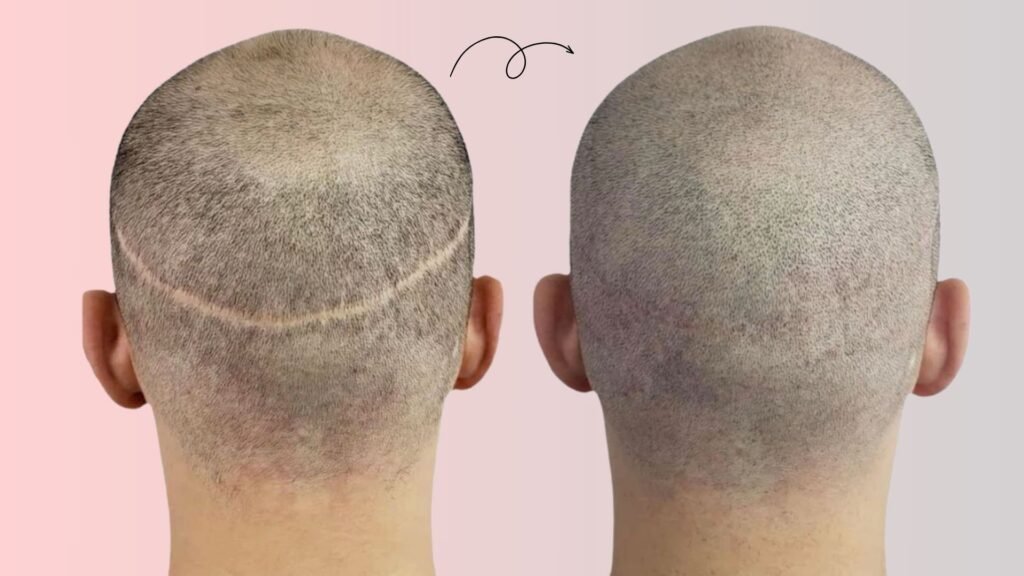How to Treat Hair Transplant Scars: Effective Solutions for Scar Repair

So, you finally went for a hair transplant, dreaming of a fuller, more natural appearance. But now, in addition to balding, you have visible scars—a daily reminder of the surgery.
It‘s infuriating. You wanted confidence, but what you got was self-consciousness about your hairline all over again.
The reality is this: scars are an inescapable aspect of hair transplants—but that doesn’t mean you‘re locked into them for life.
If you have a large FUT scar, small FUE dots, or scarring alopecia bald patches, there are methods that work to correct them. From laser resurfacing to SMP camouflage to scar revision surgery, the best solution will depend on your individual situation.
But first, let‘s discuss a harsh reality: Most individuals don‘t know that hair transplant scars have the potential to deteriorate with time unless they are well maintained.
Here’s breaking down the way to erase your past hair transplant marks and, at last, achieve your desired look.
Understanding Hair Transplant Scars: Why Do They Happen?
Every surgical hair restoration technique leaves some level of scarring, but the type and severity depend on:
✔ The technique used (FUT vs. FUE)
✔ Your skin type and healing ability
✔ The expertise of your surgeon
But there’s more to it. Lifestyle factors like sun exposure, improper post-op care, and even genetics can influence how visible your scars become.
FUT vs. FUE: The Difference in Scarring
FUT (Follicular Unit Transplantation) Scars
- Type of scar: A linear scar at the back of your scalp where a strip of skin was removed.
- Why it happens: The donor area is sutured, leaving behind a permanent line.
- How it looks: The scar can be thin or wide depending on your healing and how well the stitches were closed.
- Worst-case scenario: If not handled properly, it can stretch over time, making it more noticeable.
FUE (Follicular Unit Extraction) Scars
- Type of scar: Tiny circular scars where individual follicles were extracted.
- Why it happens: Unlike FUT, there’s no large incision—just tiny punches where follicles are removed.
- How it looks: These are much smaller and spread out, but in some cases, they become visible—especially if you keep your hair short.
- Worst-case scenario: Some patients end up with patchy, scarred areas where follicles were taken out unevenly.
Did You Know?
Even though FUE is often advertised as “scarless,” it still leaves marks—they’re just harder to see than FUT scars.
Types of Hair Transplant Scars
1. FUT Hair Transplant Scars – Linear Scar Formation
✔ Appearance: A single horizontal scar running across the back of the scalp.
✔ Cause: A strip of scalp is removed, and the area is sutured closed.
✔ Worst-Case Scenario: If not stitched properly, the scar can stretch, making it wider over time.
✔ Best Treatment: Scar revision surgery (to minimize width) or SMP (to blend it in).
2. FUE Hair Transplant Scars – Tiny Puncture Mark Scars
✔ Appearance: They leave tiny, dot-like scars throughout the donor area.
✔ Cause: Each follicular unit is extracted individually with a small circumference punch tool.
✔ Worst Case: With an inadequate extraction method, you may end up with uneven and patchy scarring on the donor site.
✔ Best Solution: SMP (Scalp Micropigmentation) or laser treatment to blur it out.
3. Scarring Alopecia – When Hair Loss Causes Permanent Scarring
✔ Issue: Smooth, shiny bald patches where hair will not grow.
✔ Cause: Follicles are irreparably damaged by autoimmune disorders, infections, or inflammatory conditions that affect hair loss.
✔ Worst Case Scenario: Hair cannot grow back in the affected area.
✔ Best Treatment: PRP therapy (for healing stimulation), SMP (for spot camouflage), or FUE transplant (for new hair growth).
The Best Treatments for Hair Transplant Scars
1. Medical & Surgical Scar Treatments
- Scar Revision Surgery – If your FUT scar is wide or raised, a skilled plastic surgeon can remove the old scar and re-stitch it more neatly, making it thinner and less noticeable.
- Hair Transplant Over a Scar – If the scar has no hair, small FUE grafts can be placed into the scar tissue to help it blend into the surrounding hair.
- FUE for Scar Repair – This technique is used to fill in bald patches on scars by carefully implanting new follicles where hair no longer grows.
Pro Tip: If you’re getting an FUE transplant over a scar, make sure your surgeon has experience working with scar tissue—it heals differently than normal skin.
2. Non-Surgical & Cosmetic Scar Treatments
- Scalp Micropigmentation (SMP) – A game-changer for scar camouflage. Tiny pigment dots are tattooed into the scar to mimic real hair follicles. This works well for both FUT and FUE scars.
- Laser Therapy – Some fractional lasers break down the scar tissue and promote collagen production, thus smoothing out and reducing the appearance of scars.
- PRP Therapy – Platelet-rich plasma injections enhance blood supply to scars so that they heal faster and promote new hair growth.
Here’s a fact clinics rarely mention: Hair transplant scars can get worse over time.
Scar stretching happens if FUT scars aren’t closed properly or if post-op care is ignored.
FUE scars can darken over time due to uneven healing.
Some scars don’t heal evenly, creating indentations that make them stand out even more.
So, what’s the fix? Keep reading—because the right treatment can erase years of regret.
3. Natural Remedies & At-Home Scar Care
- Topical Scar Remedies – Vitamin E cream and silicone gels can make scars soft after a while.
- Scalp Massage & Oils – Coconut oil, rosemary oil, and castor oil are natural home remedies that promote nourishment for scarred hair.
- Microneedling for Scars – Fine needle derma rolling triggers production of collagen and enhances the quality of scars.
Important: These treatments are most effective on small scars. For deeper scars, medical intervention is required.
How to Prevent Hair Transplant Scars from Getting Worse
✔ Follow your surgeon’s post-op care strictly (especially for FUT closures).
✔ Avoid stretching the scar by keeping your scalp moisturised and avoiding excessive tension.
✔ Protect your scalp from the sun—UV rays make scars more visible and harder to treat.
✔ Consider PRP therapy early—it boosts healing and may prevent noticeable scarring.
Choose the Right Hair Transplant Clinic for Scar Repair
✔ Look for clinics specialising in scar repair—not just general hair transplants.
✔ Request actual before-and-after pictures to observe their work on scars.
✔ Be realistic in expectations—not all treatments will result in 100% invisible scars, but they can be life-changing.
Conclusion
Scars from hair transplants can be annoying, but they need not be permanent. Regardless of whether your scars are thin, broad, or patchy, there is treatment available to correct them:
- Best for FUT scars: Scar revision or SMP
- Best for FUE scars: SMP or laser therapy
- Best for completely bald scars: FUE hair transplant over the scar
At the end of the day, the right choice depends on your goals—do you want to conceal the scar instantly (SMP)? Reduce its size (revision surgery)? Or regrow hair over it (FUE transplant)?
Scars don’t have to define your hairline. You have options—now it’s time to take control.
What’s next?
- Consult a specialist in scar repair.
- Research your best treatment based on your scar type.
- Choose a clinic that understands your unique case.
Because confidence shouldn’t come with conditions.

